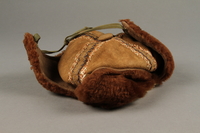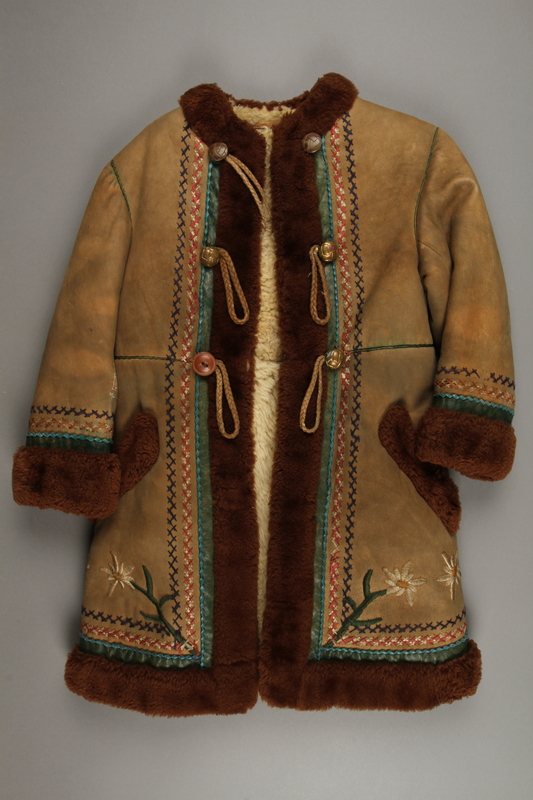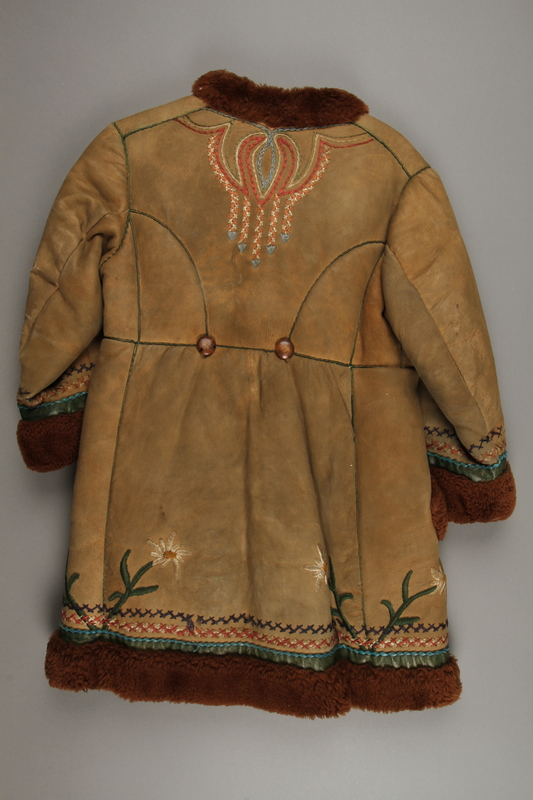Overview
- Brief Narrative
- Child's winter coat purchased by Dr. Chil Kupferblum (later Henry Kupfer), for his daughter, Tamara, while serving in the Soviet Army as a surgeon during World War II (1939-1945). In 1935, Chil received his M.D. from Karlova University in Prague, Czechoslovakia (now Czech Republic). He married Lora Shapira, and in 1938, their daughter Tamara was born. Chil’s sister, Fela, married chemist Antek Kupferblum (later Anthony Kuper), and they later settled in Warsaw. His other sister, Gertrude, married his friend, Dr. Simon Russi, and the couple immigrated to the United States. Chil was an attending physician in Rovno, Poland (now Rivne, Ukraine), when Germany and the Soviet Union invaded Poland in September 1939, and divided the territory between them. Chil’s parents, and brother, Leon, moved from Sandomierz to Rovno. Chil joined the Soviet Army, and served in a military hospital in Novosibirsk. He was still serving when Germany invaded the Soviet Union in summer 1941, and occupied Rovno on June 28. After the war ended in May 1945, Chil returned home to Rovno to learn that most of his family had been killed. Three-year-old Tamara, his wife, Lora, and parents, David and Miriam, were likely massacred in November 1941, in the nearby Sosenki Forest. His brother, Leon, had likely been killed in a ghetto liquidation, and his sister, Fela, had been murdered at Teblinka killing center in 1942. Fela’s husband, Antek, and daughter, Ewa, had survived in hiding. In 1947, Chil immigrated to the US, and later married a fellow survivor, Gertrude Zoberman.
- Date
-
acquired:
1939-1945
- Geography
-
acquired:
Soviet Union
- Credit Line
- United States Holocaust Memorial Museum Collection, Gift of Rosemarie Russi Howe
- Contributor
-
Subject:
Henry G. Kupfer
Original owner: Henry G. Kupfer
- Biography
-
Chil Gershon Kupferblum (later Henry Kupfer, 1909 - 1964) was born in Pińczów, Poland, to David Kupferblum (1881-1941?) and Miriam (Mania or Maria, 1885-1941?) nee Wechsler. Chil’s father, David, was a successful businessman, and the family lived comfortably in a spacious apartment building in Sandomierz, Poland. Chil had three siblings: Fela (1906-1942), Gertrude (Gita, later Russi, 1912-2006), and Leon Eliezer (David, 1919-1942?). Sandomierz had a large and prosperous Jewish community with a rich, long-standing cultural tradition. Many of Chil’s extended family members lived in Sandomierz, including a family of Kupferblum second cousins who lived in their building.
Chil studied medicine at Karlova University in Prague, Czechoslovakia (now Czech Republic). While in medical school, Chil invited his friend Simon Russi (1911-1991) to visit his family in Sandomierz, and there he met Chil’s sister, Gertrude. Chil received his M.D. in 1935, and later married Lora Shapira (Lara, 1914-1941?), who was from Rovno, Poland (now Rivne, Ukraine). Chil completed his residency at the City Hospital in Łódź, Poland, between 1936 and 1938. Chil’s older sister, Fela, was a teacher by training, though worked as a bank teller because antisemitism barred most Jews from teaching. In 1936, Fela married her second cousin, Antek Abram Kupferblum (later Anthony Kuper, 1903-1987), a chemist in the fur-dying industry, and the couple moved to Warsaw. In 1938, Chil and Lora had a daughter, Tamara (1938-1941?). Simon and Gertrude married in April 1938, in Pisa, Italy. In late November 1938, the couple boarded the SS Conte di Savoia in Genoa, Italy, and sailed for the United States. Simon finished his medical residency in Saint Louis, Missouri.
In 1939, Chil became an attending physician at the City Hospital in Rovno. That same year in September, Germany and the Soviet Union invaded Poland. As agreed in the Molotov-Ribbentrop Pact of August 1939, the two nations divided Poland between them. All territory east of the Bug River, including Rovno, was annexed by the Soviets, and all territory to the west, including Sandomierz and Warsaw, became part of Germany. Chil joined the Soviet Army, and was sent to Novosibirsk in southwestern Siberia (now Russia). He was a pathologist by training, but worked as a surgeon while serving in the military hospital there. Lora and Tamara stayed in Rovno while he was working in Siberia. Chil’s parents, David and Miriam, and brother, Leon, moved to Rovno, where they believed it was safer. In November 1940, Chil’s sister, Fela, husband Antek, and infant daughter Ewa (later Eva Kuper, b. 1940) were forced to relocate to the newly established Warsaw ghetto.
In summer 1941, Germany launched Operation Barbarossa, and invaded the Soviet Union. Following the invasion, Chil continued working in the military hospital in Siberia. German forces occupied Rovno on June 28, 1941. In July and August, locals killed 3,000 Jews during pogrom-style violence. On November 7, Chil’s wife, Lora, and daughter Tamara, along with his parents, David and Miriam, were likely among the 21,000 to 24,000 Jews ordered to assemble in Grabnik Square. The assembled Jews were forced to march about three miles to the nearby Sosenki Forest to be massacred. It took three days and nights to move and kill all of the assembled people. During that time, heavily armed guards beat or shot anyone that tried to escape or caused trouble, and anyone that fell behind during the march was shot. Approximately 80 percent of Rovno’s remaining Jewish population was killed during the aktion, including 6,000 children who were murdered at a separate gravesite. Soviet prisoners of war had dug the pits for the mass graves in advance. The shootings were carried-out by Police Battalion 33 (Ostland) and Police Battalions 315 and 320 of the Ukrainian Police, as well as members of the Ukrainian militia and Einsatzgruppe C, Einsatzkommando 5 [mobile killing squad C, subgroup 5]. The only Jews exempted from this aktion were those that held valid work certificates, and probably included Chil’s brother, Leon. These workers were later forced into a ghetto, and most were killed when the ghetto was liquidated in July 1942, likely including Leon.
In July 1942, mass deportations of Jews from the Warsaw ghetto began. Antek’s job at the Többens Textile Factory exempted him from deportation, but this protection did not extend to Fela and Ewa. Chil and Fela’s cousin, Regina Bankier, helped save Ewa, but Fela was transported to Treblinka killing center. In January 1943, Antek and Ewa escaped from the ghetto by travelling through the sewers. Antek put her in the care of a non-Jewish teacher and went into hiding on his own. During later round-ups, likely in 1943, Regina was deported to Treblinka.
The war ended in May 1945, following Germany’s surrender. Chil returned to Rovno to discover that his family had been murdered. He learned that Fela had also been killed, but that her husband, Antek, had survived in hiding under an alias, and her daughter, Ewa, had survived at a convent where she had been hidden since 1944. During 1945 and 1946, Chil lived in both Łódź and Bielsko (now Bielsko-Biała), Poland. In Łódź, he reconnected with family friends from Sandomierz, including Gertrude Zoberman (later Kupfer, 1917-2004), who had survived in hiding and been imprisoned in several ghettos and camps. In Bielsko, Chil lived with Antek and Ewa, who were reunited and living as non-Jews. Later in 1946, Chil relocated to Berlin, Germany, to work as a doctor in a displaced persons camp while waiting to immigrate to the US.
On January 18, 1947, Chil boarded the SS Marine Marlin in Bremen, and sailed to the US, where he changed his name to Henry Kupfer. Henry moved in with his sister, Gertrude, and her family in Fayetteville, North Carolina. Following the December 7, 1941, attack on Pearl Harbor, the US had entered World War II. In November 1942, Gertrude and Simon’s first daughter was born. In August 1943, Simon had enlisted in the US Army, Medical Corps. Not long after Henry’s arrival in 1947, the entire family relocated to Richmond, Virginia, where Gertrude and Simon’s second daughter was born. Henry quickly began learning English and studying to pass the necessary exams to practice medicine in the US. Later that year, Henry received a position in the Pathology Department at the Medical College of Virginia. In early 1949, Henry went to New York to greet Ewa, Antek, and his second wife, who were emigrating from Poland. After a brief visit with Gertrude’s family in Virginia, Henry traveled with them to Toronto, Canada, where they were settling. While there, he reconnected with Gertrude Zoberman, who had immigrated to Toronto with her family in 1948. The couple married in July 1949. They settled in Richmond, and had two children. By 1952, Henry was a full professor and served as a chairman for the Division of Clinical Pathology. Following Henry’s death, Gertrude established the Henry and Gertrude Kupfer Holocaust Education Fund through the Richmond Jewish Foundation.
Physical Details
- Classification
-
Clothing and Dress
- Category
-
Children's clothing
- Object Type
-
Coats (lcsh)
- Genre/Form
- Coats.
- Physical Description
- A child’s, knee-length, long-sleeve, brown, shearling winter coat with a decorative, colorful, stitched and dyed, geometric and floral design. The exterior of the jacket is the tanned, leather side of the shearling, while the interior bears the clipped, cream-colored fur as lining. The body of the jacket is constructed from several panels sewn together, many of the seams edged with faded, teal-colored leather piping. The six-button placket has three toggle fasteners on the upper half and seven metal hook-and-eye closures sewn along the full length. Each toggle consists of a pair of two buttons and corresponding loops of thin, braided, brown leather, one on each side of the jacket. The center and lower right buttons are all round, and lightly corroded, brass-colored metal in a stamped, basket-weave style. The other bottom button is a larger, leather-covered button, and the top two are dark brown plastic. The upper right loop is now missing. The jacket’s low, round collar, full-height placket, cuffs, slash pockets, and hem are all trimmed with sections of the material with dark brown fur on the exterior. A flat band and twisted strip of teal-colored leather edge the fur trim along the placket, hem, and cuffs. Beside these are two lines of crisscrossing, woven thread material herringbone-stitched into the surface: one in pink and cream, the other in purple. There are also six, individual, white flowers on green, leafy stems satin-stitched along the hem. On the back, just below the collar, is an additional symmetrical design element in the same thread, chain-stitched and herringbone-stitched in cream, blue, green, pink, and orange. There are two decorative, brown, plastic buttons at the center of the waist. Overall, the surface of the jacket is discolored and worn from use. The left sleeve has two short tears along the inner seam, one of which is partially repaired.
- Dimensions
- overall: Height: 26.500 inches (67.31 cm) | Width: 15.500 inches (39.37 cm)
- Materials
- overall : shearling, metal, thread, cloth, plastic, leather, dye
Rights & Restrictions
- Conditions on Access
- No restrictions on access
- Conditions on Use
- No restrictions on use
Keywords & Subjects
- Topical Term
- Holocaust, Jewish (1939-1945)--Poland--Personal narratives. Jews--Persecution--Poland. Holocaust survivors--United States. Jewish physicians--Poland--Biography. Medicine, Military--Soviet Union. Jewish ghettos--Poland--Warsaw. Jewish children in the Holocaust--Poland. Sosenki Massacre, Rivne, Rivnensʹka oblastʹ, Ukraine, 1941 Execution sites.
Administrative Notes
- Legal Status
- Permanent Collection
- Provenance
- The coat was donated to the United States Holocaust Memorial Museum in 2018 by Rosemarie Russi Howe, the niece of Dr. Henry Kupfer.
- Record last modified:
- 2024-01-03 11:24:59
- This page:
- https://collections.ushmm.org/search/catalog/irn634490
Also in Dr. Henry Kupfer family collection
The collection consists of a child's coat and matching hat purchased by Dr. Henry Kupfer, for his daughter, during his service in the Soviet Army during World War II.
Date: 1939-1945

Child’s hat purchased by Dr. Henry Kupfer for his daughter, Tamara Kupferblum
Object
Child's winter hat purchased by Dr. Chil Kupferblum (later Henry Kupfer), for his daughter, Tamara Kupferblum, while serving in the Soviet Army as a surgeon during World War II (1939-1945). In 1935, Chil received his M.D. from Karlova University in Prague, Czechoslovakia (now Czech Republic). He married Lora Shapira, and in 1938, their daughter Tamara was born. Chil’s sister, Fela, married chemist Antek Kupferblum (later Anthony Kuper), and they later settled in Warsaw. His other sister, Gertrude, married his friend, Dr. Simon Russi, and the couple immigrated to the United States. Chil was an attending physician in Rovno, Poland (now Rivne, Ukraine), when Germany and the Soviet Union invaded Poland in September 1939, and divided the territory between them. Chil’s parents, and brother, Leon, moved from Sandomierz to Rovno. Chil joined the Soviet Army, and served in a military hospital in Novosibirsk. He was still serving when Germany invaded the Soviet Union in summer 1941, and occupied Rovno on June 28. After the war ended in May 1945, Chil returned home to Rovno to learn that most of his family had been killed. Three-year-old Tamara, his wife, Lora, and parents, David and Miriam, were likely massacred in November 1941, in the nearby Sosenki Forest. His brother, Leon, had likely been killed in a ghetto liquidation, and his sister, Fela, had been murdered at Teblinka killing center in 1942. Fela’s husband, Antek, and daughter, Ewa, had survived in hiding. In 1947, Chil immigrated to the US, and later married a fellow survivor, Gertrude Zoberman.





